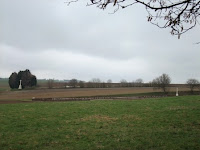A walk today around Serre, then over the Redan Ridge to Beaumont-Hamel in the morning. In in afternoon a walk around the area of Newfoundland Park.
Serre, a German Fortress village, was the northern limit of the 1st July attack (a diversionary attack was made a little further north at Gommecourt). At Serre, the British had to attack up gently sloping ground towards the German line and most were annihilated within minutes by German machine guns which had not been dealt with during the preliminary barrage.
Beaumont-Hamel was another German position of incredible strength. The village itself sat in a hollow between the Hawthorn and Redan Ridges and was flanked by machine guns on both ridges. A huge mine was blown under the redoubt on Hawthorn ridge, but the British were unable to seize the crater, allowing the Germans to re-establish machine guns in the position. It is easy here to visualize the attack of the 1st Lancs. Fusiliers, 86th brigade, 29th Div. They had tunnelled from the British front line to occupy a sunken road prior to the start of the attack on 1st July, had then to advance over an open field, then drop down a bank before advancing up a gentle slope towards the German front line. The battalion was cut to pieces in minutes of leaving the sunken lane.
Newfoundland Park is a memorial park to the Newfoundlanders. The 1st Newfounland Battalion, part of 88 Brigade (the reserve Brigade of 29th Div), were ordered to attack despite the complete failure of the two main attacking brigades due to incorrect reports of troops fighting in the German reserve positions. The 29th Div history describes eyewitness accounts of the battalion advancing 'undaunted by a hail of machine gun fire' until only a hadfull of men were left (they suffered 90% casualties). Today the park is a preserved part of the battlefield (although actually from the 1918 lines).
From the area of the park, good views across the Ancre Valley of Thiepval are to be had. In the bare fields, chalk marks can clearly be seen, actually the remnants of the chalk spoil from the deep German front line trenches and dugouts.
Image No 1: Unexploded shell, from approx approx German Front Line at Serre, overlooking British Front Line (the copses in the background)Image No 2: Taken from German Front line, Beaumont Hamel. The cemetery is in no-mans land and the memorial and hedgerow in the background is the location of the sunken lane.
Image No 3: Remains of German Front Line, Beaumont-Hamel
Image No 4: 1st Lancs. Fus. attack, Beaumont-Hamel
Image No 5: Newfoundland Memorial Park
Image No 6: Newfoundland Memorial Park
Image No 7: Thiepval, across the Ancre Valley from vicinity of Newfoundland Park. The German Front line can be followed in the bare fields as chalk marks.







Comments
Post a Comment